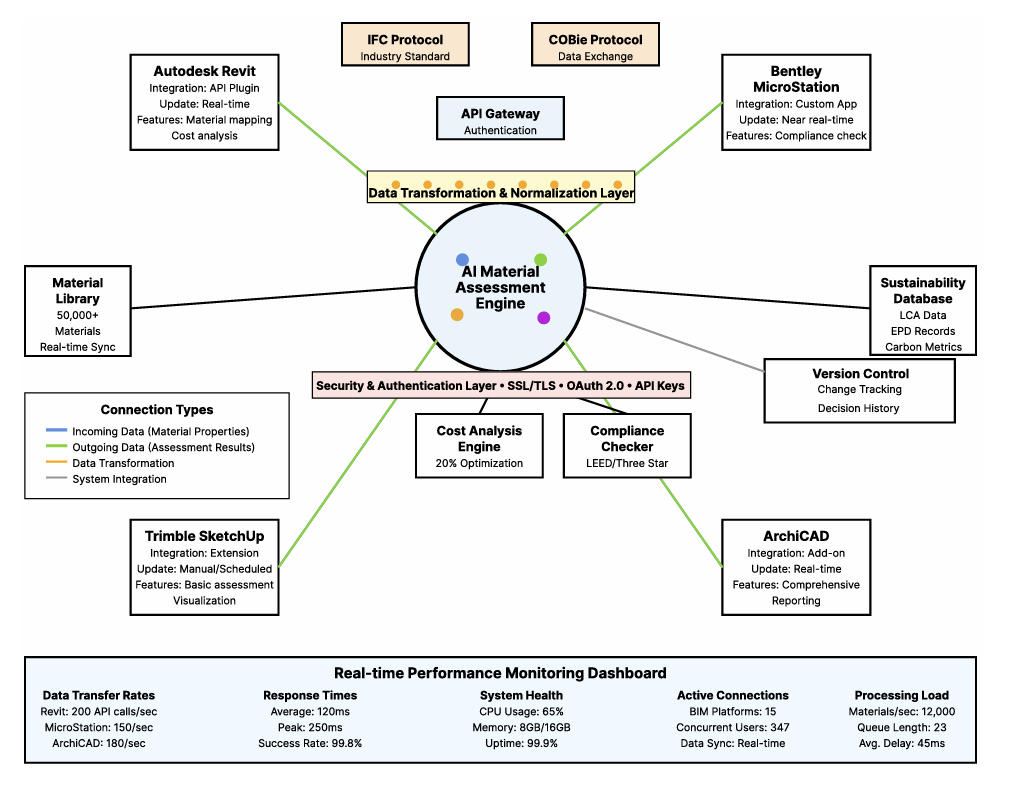AI-Assisted Sustainability Assessment of Building Materials and Its Application in Green Architectural Design
DOI:
https://doi.org/10.70393/6a69656173.333130ARK:
https://n2t.net/ark:/40704/JIEAS.v3n4a01Disciplines:
Engineering DesignSubjects:
Intelligent TransformationReferences:
24Keywords:
Artificial Intelligence, Building Materials, Sustainability Assessment, Green Architecture, BIM IntegrationAbstract
The construction industry faces unprecedented challenges in achieving sustainable development goals while maintaining economic viability and design excellence. This research presents a comprehensive AI-assisted framework for evaluating building material sustainability, addressing the critical gap between environmental consciousness and practical implementation in architectural design. The proposed methodology integrates machine learning algorithms with multi-criteria decision analysis to assess material properties including carbon footprint, durability, cost-effectiveness, and recyclability. Through extensive case studies comparing traditional and AI-assisted material selection processes, the framework demonstrates significant improvements in decision-making accuracy and environmental impact reduction. The system incorporates real-time data from global material databases and integrates seamlessly with existing Building Information Modeling tools. Results indicate a 34% improvement in sustainability scoring accuracy and 72% reduction in material selection time compared to conventional methods. The cross-cultural validation study reveals substantial differences between US and Chinese green building standards, highlighting the need for adaptive AI frameworks. This research contributes to the advancement of intelligent design methodologies and supports the transition toward sustainable construction practices in the era of Industry 4.0.
Downloads
Metrics
References
[1] Sijakovic, M., & Peric, A. (2021). Sustainable architectural design: towards climate change mitigation. Archnet-IJAR: International Journal of Architectural Research, 15(2), 385-400.
[2] Rane, N. (2023). Integrating leading-edge artificial intelligence (AI), internet of things (IOT), and big data technologies for smart and sustainable architecture, engineering and construction (AEC) industry: Challenges and future directions. Engineering and Construction (AEC) Industry: Challenges and Future Directions (September 24, 2023).
[3] Baduge, S. K., Thilakarathna, S., Perera, J. S., Arashpour, M., Sharafi, P., Teodosio, B., ... & Mendis, P. (2022). Artificial intelligence and smart vision for building and construction 4.0: Machine and deep learning methods and applications. Automation in Construction, 141, 104440.
[4] Chaowana, K., Wisadsatorn, S., & Chaowana, P. (2021). Bamboo as a sustainable building material—culm characteristics and properties. Sustainability, 13(13), 7376.
[5] Xu, S. (2025). Intelligent Optimization Algorithm for Chain Restaurant Spatial Layout Based on Generative Adversarial Networks. Journal of Industrial Engineering and Applied Science, 3(3), 32-41.
[6] Wang, X. Q., Chen, P., Chow, C. L., & Lau, D. (2023). Artificial-intelligence-led revolution of construction materials: From molecules to Industry 4.0. Matter, 6(6), 1831-1859.
[7] Nilimaa, J. (2023). Smart materials and technologies for sustainable concrete construction. Developments in the Built Environment, 15, 100177.
[8] Feng, Z., Ni, C., & Zhou, S. (2025). Option-Implied Information for Forward-Looking Market Risk Assessment: Evidence from Commodity Derivatives Markets. Spectrum of Research, 5(1).
[9] Guo, K., Yang, Z., Yu, C. H., & Buehler, M. J. (2021). Artificial intelligence and machine learning in design of mechanical materials. Materials Horizons, 8(4), 1153-1172.
[10] Mo, T., Li, P., & Jiang, Z. (2024). Comparative Analysis of Large Language Models' Performance in Identifying Different Types of Code Defects During Automated Code Review. Annals of Applied Sciences, 5(1).
[11] Zhu, P., Slater, P. R., & Kendrick, E. (2022). Insights into architecture, design and manufacture of electrodes for lithium-ion batteries. Materials & Design, 223, 111208.
[12] Yadav, M., & Mathur, A. (2021). Bamboo as a sustainable material in the construction industry: An overview. Materials today: proceedings, 43, 2872-2876.
[13] Zhu, F., Wu, X., Zhou, M., Sabri, M. M. S., & Huang, J. (2022). Intelligent design of building materials: Development of an ai-based method for cement-slag concrete design. Materials, 15(11), 3833.
[14] Feng, Z., Zhang, D., & Wang, Y. (2024). Intraday Liquidity Patterns and Their Implications for Market Risk Assessment: Evidence from Global Equity Markets. Artificial Intelligence and Machine Learning Review, 5(4), 83-98.
[15] Alemu, D., Tafesse, M., & Mondal, A. K. (2022). Mycelium‐based composite: The future sustainable biomaterial. International journal of biomaterials, 2022(1), 8401528.
[16] Wang, Y., & Wang, X. (2023). FedPrivRec: A Privacy-Preserving Federated Learning Framework for Real-Time E-Commerce Recommendation Systems. Journal of Advanced Computing Systems, 3(5), 63-77.
[17] Debrah, C., Chan, A. P., & Darko, A. (2022). Artificial intelligence in green building. Automation in Construction, 137, 104192.
[18] Liu, W., Qian, K., & Zhou, S. (2024). Algorithmic Bias Identification and Mitigation Strategies in Machine Learning-Based Credit Risk Assessment for Small and Medium Enterprises. Annals of Applied Sciences, 5(1).
[19] Almssad, A., Almusaed, A., & Homod, R. Z. (2022). Masonry in the context of sustainable buildings: A review of the brick role in architecture. Sustainability, 14(22), 14734.
[20] Sun, M. (2023). AI-Driven Precision Recruitment Framework: Integrating NLP Screening, Advertisement Targeting, and Personalized Engagement for Ethical Technical Talent Acquisition. Artificial Intelligence and Machine Learning Review, 4(4), 15-28.
[21] Serrano, W. (2022). iBuilding: artificial intelligence in intelligent buildings. Neural Computing and Applications, 34(2), 875-897.
[22] Wang, M., & Zhu, L. (2024). Linguistic Analysis of Verb Tense Usage Patterns in Computer Science Paper Abstracts. Academia Nexus Journal, 3(3).
[23] Zhong, W., Schröder, T., & Bekkering, J. (2022). Biophilic design in architecture and its contributions to health, well-being, and sustainability: A critical review. Frontiers of Architectural Research, 11(1), 114-141.
[24] Feng, Z., Yuan, D., & Zhang, D. (2023). Textual Analysis of Earnings Calls for Predictive Risk Assessment: Evidence from Banking Sector. Journal of Advanced Computing Systems, 3(5), 90-104.

Downloads
Published
How to Cite
Issue
Section
ARK
License
Copyright (c) 2025 The author retains copyright and grants the journal the right of first publication.

This work is licensed under a Creative Commons Attribution 4.0 International License.
















